MXA’S 2013 KAWASAKI KX250F MOTOCROSS TEST: THE ONE WITH DUAL-FUEL
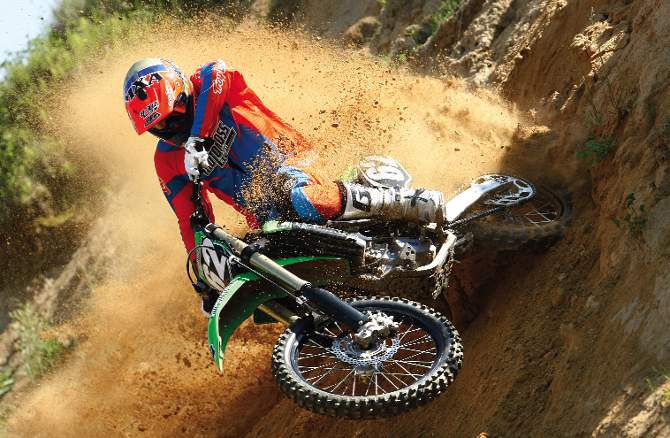
FIRST AND FOREMOST, IS THE 2013 KX250F BETTER THAN THE 2012 KAWASAKI KX250F?
A: Yes! Last year the KX250F romped the competition in the MXA 250 four-stroke shootout. To say that the 2013 model is superior doesn’t bode well for other manufacturers.
Q: WHAT SIGNIFICANT CHANGES WERE MADE TO THE 2013 KAWASAKI KX250F?
A: Before we answer that question, we’re compelled to discuss the major updates that Kawasaki’s engineers implemented on the KX250F in the past several years.
2011 model: (1) The KX250F joined the electronic fuel injection fray (using their own marketing jargon by calling it “Digital Fuel Injection”) with a 43mm Keihin throttle body. Unfortunately, the switch to EFI tamed the once-potent powerband. (2) This was also the first year of the Showa Separate Function (SFF) fork, where the right fork leg housed a spring and the left fork contained the piston rod damper, air chamber and most of the fork oil. (3) After having won our shootout four out of the previous five years, the KX250F finished in the runner-up position in 2011. Electronic fuel injection was the culprit.
2012 model: (1) Kawasaki’s fleet of engineers and scientists aren’t afraid to push the technological envelope. Need proof? Last year’s bike was the first to come with dual fuel injection. The primary injector sprays fuel into the engine from off-idle at 5000 rpm to 7000 rpm. Then, at higher rpm, the four-hole upstream injector delivers a secondary burst of fuel. It’s a marvel. (2) The 2012 KX250F also received numerous engine updates, which helped boost horsepower to 39.55 horsepower. To complement the engine, Kawasaki beefed up the suspension spring rates, turning the KX250F into a serious racing steed.

Q: WHAT’S THE BIG DEAL ABOUT THE 2013 KAWASAKI KX250F?
A: Quite honestly, we didn’t expect Kawasaki to pour research and development dollars into the 2013 KX250F, and for good reason. The 2012 model was so advanced that it embarrassed every other 250 four-stroke. While it had its faults, the engine and suspension were so unbelievably good that any issues were overshadowed by the two most important areas of the bike. However, the 2013 KX250F does, in fact, have a shopping cart full of updates. Kawasaki focused on 11 areas of concern.
(1) Engine. A new intake tract provides a straighter path to the engine, houses the air temperature sensor in a different position, improves shielding for the upstream fuel injector and is easier to install. Due to the revised intake tract, the cylinder head intake routing was also changed (with a focus on “downdraft” flow). The intake valve seats are steel and allow for improved long-term engine performance. The intake cam timing was retarded by 4 degrees for increased high-rpm power.
Other changes include a repositioned upstream fuel injector that is also rotated for greater power optimization. The throttle position sensor (TPS), idle knob and fuel-line fitting have been revised to improve durability, as well as ease adjustment. A shorter cylinder head (by 0.10mm) increases the compression ratio (from 13.5:1 to 13.8:1) for improved bottom-end performance. The bridged-box piston’s skirt has a softer arc area for improved durability, and the spark-plug cap offers a tighter seal. Kawasaki also increased the inertia of the ignition rotor for enhanced traction.
(2) Exhaust. Add the KX250F to the growing list of bikes that come with a resonance chamber. The advantages of a resonance chamber include increased bottom-end performance without affecting top-end power and quieter acoustics. The exhaust is still made of stainless steel. As for the muffler, the canister length has been shortened by 30mm and has 12.5mm more girth. The outlet diameter is 7mm wider for improved flow characteristics. In case you’re wondering, last year’s exhaust system will fit on the new bike.
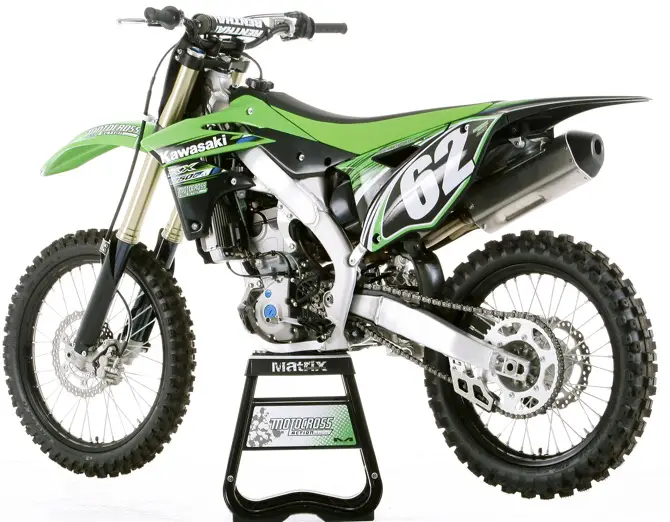
2013 KX250F: This isn’t a carryover model from last year. Kawasaki refined an already excellent bike by using a narrower frame, new swingarm, and an exhaust system with a resonance chamber (among other things).
(3) Map couplers. Just as with the KX450F, the KX250F comes with three interchangeable coupler caps. The couplers are color-coded (green=standard, white=aggressive, black=soft) and change engine performance. Located on the steering head, the couplers can be switched out in less than 30 seconds.
(4) Chassis. A carryover concept from the KX450F last year, the new KX250F frame is 4mm narrower for improved feel and slimmer ergonomics (the KX250F frame is different from the KX450F chassis). Rigidity has been increased in the steering head and shock tower, as well as the upper engine mount. The lower triple clamp now opens from the rear (as opposed to the side as in years past) for greater rigidity, and the bolt holes are on the sides of the clamp (instead of the front).
(5) Swingarm. A new swingarm is 20mm longer and offers up to 4.2 percent more torsional rigidity and enhanced durability. The twin, tapered, hydroformed spars feature a natural aluminum finish to help maintain appearance, and the chain adjusters are forged for maximum precision.
(6) Forks. The KX250F still comes with Showa’s Separate Function Fork (SFF), but the fork tubes are larger (48mm). The axle lugs have been redesigned, and the fork’s preload adjuster uses a 17mm wrench (instead of 21mm) for easier access. Regarding the preload adjuster, four clicks now equate to 1mm of preload (the old adjuster needed six clicks for the same amount of preload). The left fork leg, which houses the damper and oil, comes with a larger sub-piston, main piston and new oil diaphragm for firmer damping performance. The right leg has a new upside-down joint rod, under-spring lock nut, and the aforementioned spring preload adjuster.
(7) Shock. As for the Showa Uni-Trak shock, settings have been revised to provide more compression and rebound damping. The rear spring preload has been reduced by 2.3mm to match the chassis and fork revisions. Kawasaki’s objective was to match the shock with the updated fork settings.
(8) Styling. To the casual observer, the 2013 KX250F looks like the KX450F. There is good reason for that. The KX250F now shares the majority of its plastics with big brother?front number plate, side panels, rear fender, front fender and the seat. The shrouds, radiator louvers, skid plate and engine guards are different between the two bikes. A flatter seat and new, low-profile, 1.6-gallon fuel tank make for easier rider movement. And, for greater aesthetic appeal, the clutch and ignition covers are silver instead of black.
(9) Controls. Kawasaki finally addressed our incessant groans regarding the terrible handlebar grips by using a softer compound. They also lengthened the grips by 10mm, and the throttle-side grip is now glued to the throttle tube instead of vulcanized on. Hallelujah!
(10) Brakes. A push-rod-style front-brake master-cylinder linkage replaces the old knocker-style linkage, where the lever pushed directly on the master cylinder piston, for stronger initial bite and better modulation. Complementing the update are new front brake pads with a higher coefficient of friction (for stronger braking force and better feel).
(11) Chain guides. Kawasaki may understand that they have a problem with their chain guide and buffer pad, but they are only idling toward a solution. For 2013, they addressed one issue by using a high-density urethane chain buffer pad (the chain guide is unchanged).
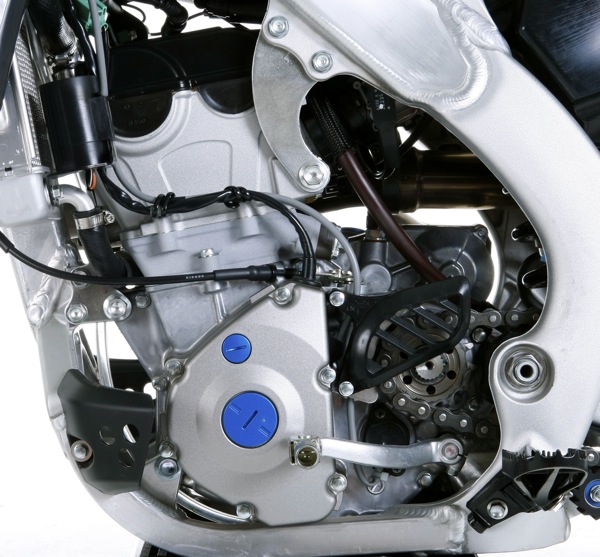
Power up: The KX250F is once again blessed with a meaty powerband that works well in many situations. Just twist and go!
Q: WHAT’S THE MOST IMPORTANT CHANGE ON THE 2013 KX250F?
A: Nothing! There’s not a single change that defines the new KX250F. That’s not necessarily a bad thing. Like Leonardo da Vinci putting the finishing touches on the Mona Lisa, Kawasaki didn’t paint outside the KX250F’s already beautiful lines.
Q: HOW DOES THE 2013 KAWASAKI KX250F COMPARE TO LAST YEAR’S MODEL ON THE DYNO?
A: Both engines are essentially the same from 6000 rpm to 10,200 rpm, then the 2013 KX250F takes off like a striped cat. The 2013 KX250F makes 41.16 horsepower compared to 39.55 last year. Torque is about the same. In what has become a horsepower duel in 2013, the KTM 250SXF’s 42.89 horsepower is the king, but the two bikes match each other in the power race until the top end, where the extra horsepower and the extra rpm favor the Austrian 250.

Q: HOW FAST IS THE 2013 KAWASAKI KX250F?
A: Given that the 2012 KX250F blew away expectations with its incredible powerband, we expected nothing less from the 2013 model. We weren’t disappointed. The biggest compliment that we can pay to Kawasaki’s 250 four-stroke engine is that it doesn’t do anything glaringly wrong. In a category where a potent powerband trumps all other areas (suspension, handling, shifting, brakes, etc.), the KX250F is still a leader.
There’s a tremendous gap between the most usable powerband and the most powerful powerband. For a 250 four-stroke, the KX250F’s output is supremely usable. Slower riders enjoyed the explosive bottom-end hit, while those with more experience adored the midrange pull. Pro-level riders found it best to keep the engine in the meat of the powerband and shift often.
How does the 2013 KX250F compare to the 2013 KTM 250SXF? They may be peas in a pod on the dyno, but the KX250F revs quicker and hits with a more pronounced bark in the middle, while the KTM never gives up the ghost, revs to an amazing 14,000 and has no equal on top-end power. The KX250F has a better all-around powerband that suits a wide range of skill levels, while the KTM 250SXF is a Pro-level machine that favors the talented.
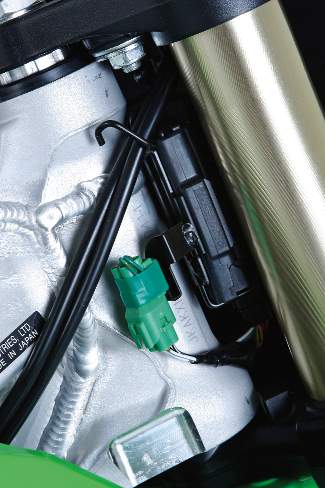
Something borrowed:?Just like the KX450F last year, the 2013 KX250F comes with three different couplers.
Q: DO THE AGGRESSIVE AND SOFT MAP COUPLERS REALLY MAKE A DIFFERENCE?
A: The 2013 KX250F comes with two optional preprogrammed map couplers. The green coupler is stock. The white coupler is aggressive. The black coupler is mellow.
Which coupler is like baby bear’s porridge? Most MXA test riders favored the white (aggressive) coupler. It spiced up the KX250F engine and increased the over-rev capabilities. The green (standard) coupler was our second-favorite option. The black (soft) coupler was our least favorite. We would only use this map when racing on ice or linoleum.
Q: WHAT IS THE SUGGESTED RETAIL PRICE OF THE 2013 KX250F?
A: $7599. Kawasaki has raised the price of the KX250F by $600 over the last four years. Blame it on inflation and the cost of the two extra couplers. For the sake of comparison, the 2013 Yamaha YZ250F is $300 cheaper, the Suzuki RM-Z250 is the same price, and the KTM 250SXF is $200 more expensive.
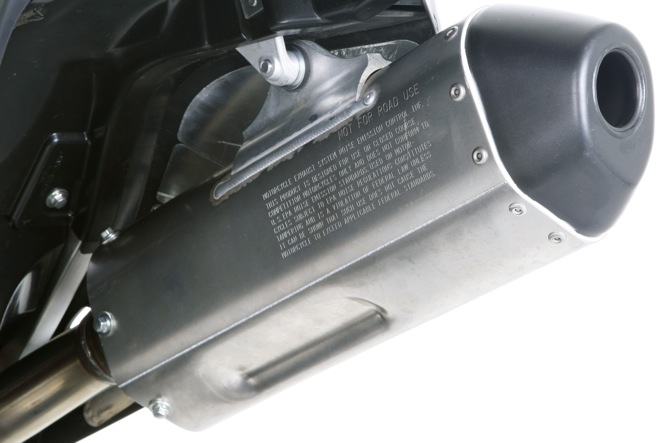
Q: HOW GOOD IS THE SHOWA SUSPENSION?
A: Just like the Apple iPhone, the KX250F suspension gets better every year.
Forks: Kawasaki made a spring-rate change to the SFF fork last year, going stiffer to accommodate faster and heavier riders. It was a wise idea. For 2013, the fork tubes are larger, which equates to increased rigidity and less deflection (both good traits). We like the option of changing ride height by adjusting preload. Most test riders were satisfied with the stock preload, but shorter riders loved the idea of being able to let the bike sag in a little farther.
Shock: The incessant wallow that plagued the KX250F for years has (finally) been addressed by Kawasaki. Although the rear end still suffers from a wiggle under extreme circumstances, it’s much better than before. As for the shock, it has a tendency to feel dead if not set up properly. Pay close attention to sag and don’t go overboard when adjusting the high-speed compression.
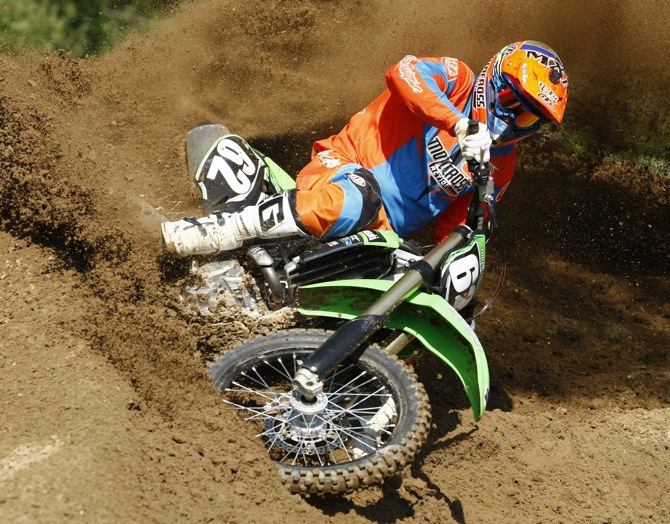
Q: DOES THE NARROWER FRAME MAKE A BIG DIFFERENCE IN HANDLING?
A: We’d love to gush about how the narrower frame makes the 2013 KX250F corner like it’s on rails, but we’d be telling tales out of school. The slimmer cross-section does make the bike feel svelte, but pinpoint front-end precision is not really improved. Instead, by adding rigidity to the shock tower, using a new upper-engine mount and slapping on a 20mm longer swingarm, the KX250F gained stability while reducing the dreaded wallowing. So, to answer the question, the frame didn’t equate to a sharper-handling bike, but a combination of factors helped diminish problems in the rear end.
Q: WHAT DID WE HATE?
A: The hate list:
(1) Shifting. Every new model year we wish for a KX250F transmission that will shift under a heavy load. Every year our dreams are shattered.
(2) Clutch. At the very least, invest in stiffer aftermarket clutch springs or you will be investing in eight new clutch plates every month.
(3) Chain guide. We suggest you call T.M. Designworks.
(4) Black rims. Black rims have curb appeal, but after a few rides they become scratched. They’re also a pain to clean.
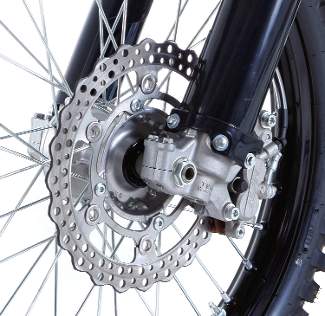
Getting there:?While the new brake caliper is stronger than ever before, it’s still not the best brake in the business.
Q: WHAT DID WE LIKE?
A: The like list:
(1) Engine. Let’s not be shy about our romance with the KX250F engine. It covers a wide spread of the powerband and doesn’t have any glaring weaknesses.
(2) Upstream injector. We loved it last year, and it has only gotten better. Dual fuel injection is like going on a date with Kate Upton and Bar Refaeli?twice the fun!
(3) Frame. The narrower frame has improved rider feel. The focus on rigidity has also improved rear-end and straight-line stability.
(4) Suspension. Every year the KX250F receives suspension improvements geared toward the racing demographic. 2013 is no different. The increased fork rigidity, along with revised settings, allowed test riders to push the boundaries.
(5) Brakes. The push-rod-style front-brake caliper offers more bite than last year. It’s a few steps down the ladder from the phenomenal KTM brakes, but it’s a step in the right direction.
(6) Couplers. Motocross riders like options, and with three different couplers to choose from, you can change the engine characteristics of the KX250F.
(7) Styling. The new plastics and black rear fender give the Kwacker a race-inspired look. One caveat: after you gouge up the black rims, re-lace the wheels with silver rims.
Q: WHAT DO WE REALLY THINK?
A: We commend Kawasaki for their continued insistence on improving their bikes, and the 2013 KX250F is a prime example of that commitment. As a result, they have managed to tweak the KX250F to the point of near perfection. The bike was a world-beater last year, and it has only gotten better, thanks to a more usable engine, narrower ergos, quick-change mapping and suspension upgrades.
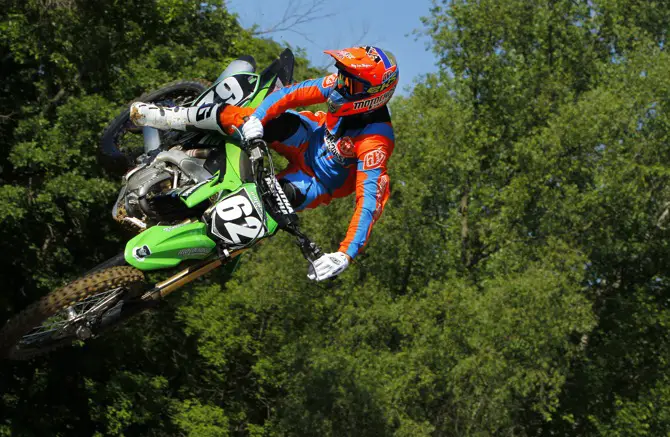
MXA’S 2013 KAWASAKI KX250F SETUP SPECS
This is how we set up our 2013 Kawasaki KX250F for racing. We offer it as a guide to help you get your own bike dialed in.
SHOWA SFF FORK SETTINGS
The MXA wrecking crew likes the various options that the Showa SFF fork provides. Ride height is very important, as it determines the handling traits. Too much ride height yields a vague feeling at turn-in. To measure ride height, have the rider sit on the bike. Measure from the bottom of the right fork guard to the dust seal. For hardcore racing, we recommend this fork setup for the 2013 Kawasaki KX250F (stock specs are in parentheses):
Spring rate: 0.97 kg/mm
Oil height: 320cc in left leg, 235cc in right leg
Compression: 10 clicks out (8 clicks out)
Rebound: 10 clicks out (11 clicks out)
Preload adjuster: 15 clicks in
Fork leg height: 5mm up
Notes: Kayaba developed a new spring preload adjuster that is considerably more user-friendly. The cap size is now 17mm instead of 21mm. Additionally, four clicks on the adjuster equals 1mm of preload (the old cap needed six clicks for 1mm).
SHOWA UNI-TRAK SHOCK SETTINGS
Although better than in 2012, the KX250F rear end still wallows under hard acceleration and through continuous bumps. To prevent this sensation, we crank in on the high- and low-speed compression and adjust the rebound according to rider preference. Might we also recommend a longer pull rod to change the curve? For hardcore racing, we recommend this shock setup for the 2013 Kawasaki KX250F (stock specs are in parentheses):
Spring rate: 5.4 kg/mm
Race sag: 100mm
Hi-compression: 1-1/2 turns out (2 turns out)
Lo-compression: 10 clicks out (12 clicks out)
Rebound: 10 clicks out (12 clicks out)
Notes: These settings are geared toward a heavier rider (170-plus pounds). We think that the KX250F works best with the low-speed compression turned in while using the high speed to adjust the ride height at speed.





Comments are closed.